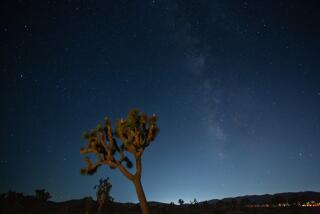Guided by the light
- Share via
I tilt the telescope skyward and reach in through the struts of its skeleton tube to uncover the concave primary mirror, which returns a fleeting, funhouse image of my face -- big, goofy jowls and diminished brow -- as if to underscore the preposterousness of my primate pretensions, an ape out to learn about the cosmos. The mirror, wide as a serving platter and thick as a phone book, is figured in a parabola to an accuracy of better than one-eighth of the wavelength of sodium light, but until it reaches the same temperature as the surrounding air it will be somewhat warped. While waiting for the mirror to cool down, I sit at the desk, switch on a small red night-vision light (red light, long in wavelength and relatively low in energy, minimizes dazzle to the dark-adapted eye), and make an entry on the ruled page of the observatory logbook: Sky cloudless. Light southwest wind. Humidity sixty-seven percent and falling.
I consult a favorite old star chart. Its vanilla pages, crossed by thin grid lines on which the stars and nebulae hang like grapes on a trellis, are dotted with inked-in notes on observations made over the years: the trails of comets past; a penciled dot locating a quasar, its light a few billion years old; and the numbered distances of stars and nebulae, part of a lifelong effort to comprehend our immediate neighborhood, out to just a couple of thousand light years or so, in three dimensions. But most of the inscriptions refer to galaxies, each designated by an unfilled oval on the star chart, each home to a hundred billion stars. The darkness is deepening, and their hour is at hand.
-- Timothy Ferris, from ‘Seeing in the Dark’






